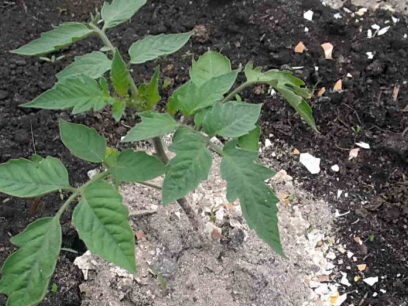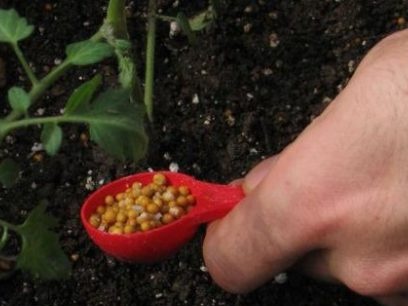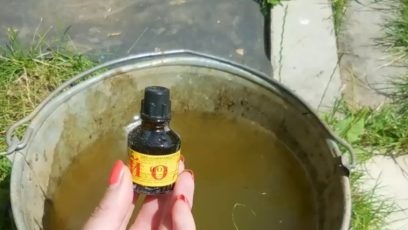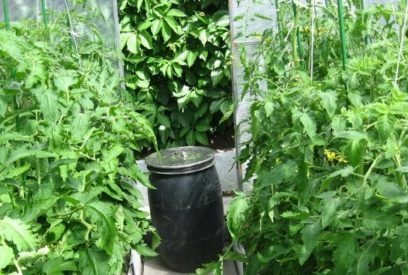The taste quality of tomatoes is determined not so much by sugar content as by the correct balance between sugars and acids in the juice and pulp of the fruit. But if very sweet, the so-called “dessert” tomatoes, usually get high tasting marks, then too sour tomatoes can be considered a marriage. The risk of harvesting tasteless fruits rises in rainy or, conversely, arid summers. But with the help of top dressing, the processes of accumulation of sugars in fruits can be stimulated.
Content
What determines the sweetness of tomatoes
 Tomatoes have a pleasant sweet taste if they contain a sufficient amount of glucose and fructose, which directly depends on the proportion of solids (sugars make up 50% of their volume). The concentration of acids, especially malic and glutamic, should not be too high. Polyphenols, amino acids, carotenoids, fats and vitamins also affect the taste of tomatoes.
Tomatoes have a pleasant sweet taste if they contain a sufficient amount of glucose and fructose, which directly depends on the proportion of solids (sugars make up 50% of their volume). The concentration of acids, especially malic and glutamic, should not be too high. Polyphenols, amino acids, carotenoids, fats and vitamins also affect the taste of tomatoes.
The process of accumulation in the fruits of these substances depends on many factors:
- varietal characteristics of the plant;
- amount of sunlight;
- soil acidity level;
- temperature condition;
- frequency of watering.
Last but not least, the quality of the nutrition of the bushes also affects the taste. Top dressing is most important at the stage of budding, after the formation of the ovaries and during the filling of the fruits. During these periods, plants should receive a sufficient amount of potassium and phosphorus, while the proportion of nitrogen in the fertilizer should be limited. Nitrogen stimulates the growth of fruits, but makes them watery and acidic.
Fertilizers for sweets
 Fertilizing tomato bushes should be given every 10-15 days. It is recommended to use different types of fertilizers and not be limited to watering under the root - some of the substances should be applied by the foliar method.
Fertilizing tomato bushes should be given every 10-15 days. It is recommended to use different types of fertilizers and not be limited to watering under the root - some of the substances should be applied by the foliar method.
Mineral fertilizers
Phosphorus and potassium will help improve the taste of tomato fruits. There are products that contain both substances, but you can prepare the mixture yourself. To feed tomatoes, you can use:
- Superphosphate (double or normal). Source of phosphorus. With a solution of the substance, you can water or spray the bushes along the sheet. It is especially useful to spray the ovary with a superphosphate extractor. To prepare fertilizer for irrigation, you must first dissolve the granules or powder in a small amount of boiling water in a ratio of 1:10 and leave the mixture for a day, stirring occasionally. For spraying, the base must be made less concentrated - pour about 15 g of powder or granules in a liter of boiling water. The finished mixture should be diluted with water - 10 liters per 300 ml of concentrate. Potassium sulfate (in advance) or potassium nitrate (immediately before use) can be added to the solution.
- Potassium sulfate. Used for feeding potassium. For watering tomatoes in a bucket of water, you need to dissolve 20 g of the substance, for spraying - 10 g. The substance can be added to a solution of superphosphate or wood ash, combining potash with phosphorus.
- Potassium nitrate. An alternative to potassium sulfate, suitable for root dressing. The solution is prepared by dissolving 20 g of powder in 10 liters of water. Nitrate can be added to the ash solution or superphosphate extract. In the second case, the product should be used immediately, not leaving for storage. The last top dressing with potassium nitrate should be done no later than a month before harvesting the fruits.
- Potassium Monophosphate. Contains both elements.For root top dressing in a bucket of water you need to dissolve 15 g, for spraying - 2 g of the substance. When buying a product, it is worth giving preference to a granular form, since the powder dissolves worse in water.
- Diammofoska. Complex fertilizer that contains 26% phosphorus, 26% potassium and 10% nitrogen. The substance must be applied to the soil in the spring, 1 tablespoon per 1 m2 or half a teaspoon in the landing hole. After this, the soil needs to be watered abundantly. When using the drug, there is no need for phosphorus-potassium top dressing during the season, except in cases of cold or rainy summers.
- Humates. They can also increase the sweetness of tomato fruits. Funds based on them must be paid at the root. In 10 liters of water should dissolve a tablespoon of drugs such as "Gumat-80", "Gumat Universal", etc. Before top dressing, bushes must be abundantly watered.
- Magnesium sulfate. The element is necessary for photosynthesis processes, the sweetness of the fruit also depends on the quality of which. It is useful a couple of times a season to spray tomato bushes with a solution of 15 g of magnesium sulfate per 10 liters of water. In rainy summers or for tomatoes growing in a film greenhouse, such top dressing should be given at least 2 times a month.
Organic fertilizer
 Wood ash is considered the best organic top dressing to improve the taste of tomato fruits. The fertilizer contains a large amount of potassium, as well as calcium and magnesium. A similar composition has a green infusion. Cow manure and bird droppings in the period after flowering of bushes should be given very moderately due to the high concentration of nitrogen in them.
Wood ash is considered the best organic top dressing to improve the taste of tomato fruits. The fertilizer contains a large amount of potassium, as well as calcium and magnesium. A similar composition has a green infusion. Cow manure and bird droppings in the period after flowering of bushes should be given very moderately due to the high concentration of nitrogen in them.
Recipes for organic dressing:
- Infusion of wood ash. A bucket of boiling water should be poured 1 kg of ash and leave for a day. Ready infusion bushes should be watered at the root of half a liter per adult plant. Top dressing should be given three times a season with breaks of 14 days. The most beneficial effect on the taste of tomato irrigation is ash infusion at a time when the fruits begin to turn brown.
- Green infusion. The best raw material for green manure is nettles, but you can use almost any grass - dandelion, plantain, lawn grass. The main thing is not to take poisonous plants. The plant mass should be crushed and filled with water in a ratio of 1: 2. The mass is left to roam under the lid for a week. To stimulate the process, you can add yeast, but if the weather is warm, it will be enough to place the fertilizer tank in a sunny place. Each liter of the finished infusion must be diluted with 5 liters of water and pour the tomatoes with a solution.
Folk Tricks
 Seasoned gardeners, in addition to traditional top dressing, recommend using the following means as fertilizers for tomatoes:
Seasoned gardeners, in addition to traditional top dressing, recommend using the following means as fertilizers for tomatoes:
- Potassium permanganate. During the flowering period, the bushes need to be watered with a 0.02-0.03% solution of potassium permanganate. Each plant requires 0.5 liters of remedy.
- Iodine. A low concentration of iodine solution can be applied under the root or sprayed with plants. In the first case, 3 drops of a pharmaceutical preparation should be diluted in 10 liters of water. For each bush you need to pour 0.7 liters of solution, for tall tomatoes - 1 liter. Use iodine for spraying only in a mixture with milk - 1/4 liter per 1 liter of water. 5 drops of iodine should be added to the milk solution.
- Boric acid. The substance is used mainly for foliar top dressing, since tomato roots absorb boron worse. In a liter of water you need to dilute 10 g of boric acid. Spray should be after the formation of ovaries.
- Milk serum. 1 part of the product must be diluted in 4 parts of water. With this solution, you need to water the tomatoes in a bucket on the bush about 3-4 times per season.
Taste and Grade
 Top dressing can improve the taste of tomatoes only to a certain extent; vegetable genetics has a greater effect on the accumulation of sugars in fruits. The sweetest varieties of tomatoes are bred by the people, while the fruits of modern hybrids are often acidic or tasteless. In the pursuit of weight, keeping quality, presentation, early maturity of the fruit, breeders temporarily lost sight of their taste. Fortunately, among the latest trends in tomato breeding has become a return of priority to the taste of fruits.
Top dressing can improve the taste of tomatoes only to a certain extent; vegetable genetics has a greater effect on the accumulation of sugars in fruits. The sweetest varieties of tomatoes are bred by the people, while the fruits of modern hybrids are often acidic or tasteless. In the pursuit of weight, keeping quality, presentation, early maturity of the fruit, breeders temporarily lost sight of their taste. Fortunately, among the latest trends in tomato breeding has become a return of priority to the taste of fruits.
In addition, there is a certain correlation between taste and weight, color, early ripening of fruits. Late and medium varieties are often sweeter than the early ones, and small tomatoes are mostly more sugar than large ones. By color, pink and black varieties are considered the sweetest.
Sweet large-fruited tomato varieties:
- Pink honey (600-1500 g);
- Camellia (800 g);
- Raspberry giant (600-700 g);
- Eagle's beak (300-800 g);
- Orange strawberries (300-700 g);
- Hospitable (400-600 g);
- Appetizing (400 g);
- Honey saved (200-600 g);
- King of Siberia (300-400 g).
Sweet large-fruited varieties for covered ground:
- Tsarin (300-600 g);
- Alexander the Great (300-350 g);
- Striped Chocolate (350-500 g).
Sweet early tomato varieties:
- Snowdrop (100-120 g);
- Melody (180-230 g);
- Irina (100-120 g);
- Bagheera (200-250 g);
- Riddle (100 g);
- Snow Leopard (150 g).
Sweet early varieties for indoor use:
- the fire (150-180 g);
- Major (200-270);
- Malachite box (250-300 g);
- Coral reef (300-320 g).
Very sweet small-fruited varieties:
- Bead (15 g);
- Magic harp (20 g);
- Waterfall (20-25 g);
- Honey drop (30 g);
- De barao (60-90 g);
- Roma (80 g).
Do not underestimate the effect of care on the palatability of a tomato. If the plant does not receive a sufficient amount of light, grows on soil with high acidity, suffers from excess moisture, neither nutrition nor the choice of a sweet variety will help - the fruits will have a sour taste. Tomatoes become tasteless at temperatures from 35 ° C, lack of watering, if bushes are not formed.




 Low-growing tomatoes, without pinching: 5 of the most delicious varieties
Low-growing tomatoes, without pinching: 5 of the most delicious varieties Why tomato seedlings grow poorly
Why tomato seedlings grow poorly We grow a tomato in a shell
We grow a tomato in a shell Growing tomatoes without watering according to the method of Kazarin
Growing tomatoes without watering according to the method of Kazarin
Very reasonable and competent article, thanks.